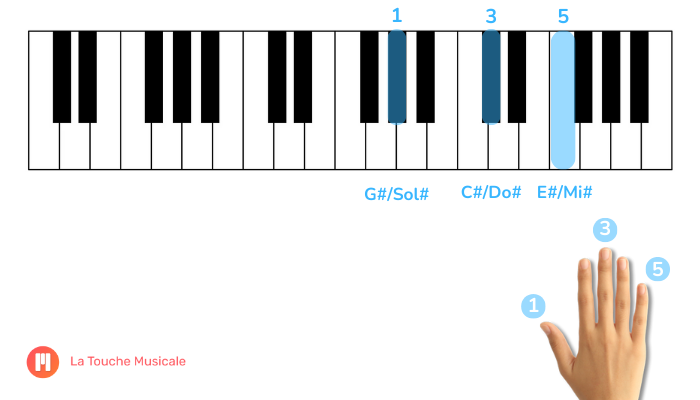
The C# major chord is distinguished by its ability to inject vitality into any musical composition. Located a semitone above the C major chord, this rich, vibrant chord offers a distinctive tonal palette, conducive to creative exploration on the piano. This article aims to unveil the essential techniques for mastering the C# major chord, providing pianists of all levels with the tools they need to enrich their repertoire and express the full range of musical emotions.
Learn chords and more with the La Touche Musicale app
C# major is a musical chord composed of three main notes: C#, E# and G#. This chord is formed on the basis of a major triad, meaning that it comprises a root note (C#), a major third above this root note (E#), and a fifth just above the root note (G#). The sound of the C# Major chord is often described as bright and cheerful, making it popular in a wide variety of musical genres, from pop to jazz.
G♯ – Fifth finger (5)
E♯ – Third finger (3)
C♯ – First finger (1)


G♯ – First finger (1)
E♯ – Third finger (3)
C♯ – Fifth finger (5)


Learn chords and more with the La Touche Musicale app
C♯ – Fifth finger (5)
G♯ – Second finger (2)
E♯ – First finger (1)


E♯ – Fifth finger (5)
G♯ – Third finger (3)
C♯ – First finger (1)


E♯ – Fifth finger (5)
C♯ – Third finger (3)
G♯ – First finger (1)


G♯ – Fifth finger (5)
C♯ – Third finger (3)
E♯ – First finger (1)


Learn chords and more with the La Touche Musicale app
You can master the C# major chord by practicing a number of exercises, which we reveal below. You can also use our interactive app La Touche Musicale, which will wait for you to play the right notes of the chord before moving on to the next notes.
Here are a few exercises you can practice frequently:
Objective: To familiarize your hands with the position and sound of the C# Major chord.
Exercise: Press the notes C#, E# and G# simultaneously (see our diagram above for finger positions) to form the C# Major chord. Repeat this chord several times, slowly at first, then gradually increasing the speed. Practice with each hand separately, then together.
Objective: Increase your flexibility and chord fluidity on the keyboard.
Exercise: Learn and practice the three positions of the C# Major chord: the root position (C#-E#-G#), the first inversion (E#-G#-C#), and the second inversion (G#-C#-E#). Play each inversion separately, then link them together in a flowing movement.
Objective: To improve the transition between the C# Major chord and other chords.
Exercise: Choose a second chord (e.g. F# Major) and practice the transition from the C# Major chord to this second chord and vice versa. Start at a slow tempo, concentrating on precise fingering, then gradually increase your speed of execution.
Objective: To develop finger independence and fluidity.
Exercise: Play the notes of the C# Major chord one by one, ascending and descending. Start with the right hand, follow with the left, then use both hands. Vary the arpeggio pattern to include inversions.
Objective: Use the C# Major chord in a musical context.
Exercise: Improvise or compose short musical pieces or chord progressions using the C# major chord as a central element. Try incorporating different inversions and rhythms to explore the chord’s versatility.
By incorporating these exercises into your practice routine, you’ll strengthen not only your technique but also your musical understanding of the C# Major chord, an invaluable tool for any musician.
This romantic song relies heavily on piano chords, including D♭ major, to support the stirring vocal melody. Although technically in D♭ major, this represents the harmonic equivalent of C# major.
The part sung by Alicia Keys in this famous New York tribute uses chords that can be transposed or conceptualized as C# major / D ♭ major, providing a rich, melodious backdrop to this popular composition blending rap, pop and RnB.
One of singer Adele’s best-known tracks uses chords that include D♭ major to produce a strong nostalgic feeling in her audience. The song brilliantly exploits the full range of emotions conveyed by this chord and its variations.
The C# major chord, with its brilliant sonority and ability to elevate the emotion of a musical composition, is an essential tool in every musician’s arsenal. Mastering this chord not only opens the door to a rich palette of musical expression, but also enriches the understanding of harmonic subtleties. Whether in romantic ballads or rhythmic pieces, the C# major chord continues to play a central role in the creation of memorable and moving works. We therefore recommend that you practice playing this chord and its inversions through the interpretation of popular tunes or through your own compositions.
It’s a triad made up of a root note, a third and a fifth.
G♯ – Fifth finger (5)
E♯ – Third finger (3)
C♯ – First finger (1)
C♯ – Fifth finger (5)
G♯ – Second finger (2)
E♯ – First finger (1)
E♯ – Fifth finger (5)
C♯ – Third finger (3)
G♯ – First finger (1)
La Touche Musicale is a popular app specialized in piano learning. You can register for free and learn to play your favorite songs with this chord and many others.
You can use our La Touche Musicale app or browse our blog category to learn how to play all the popular piano chords.
Help democratize piano learning by sharing this article:
Learn to play all the chords to your favorite songs on the piano




Legal